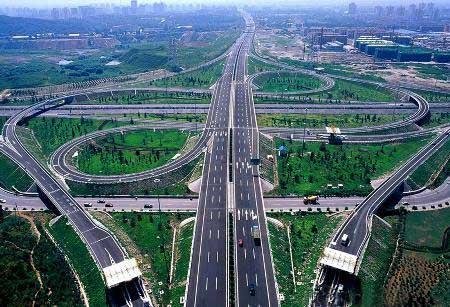Sixth Ring Road to open for traffic before National Day
2009-09-08 16:36 BJT
Recently, reporters learned from Beijing Railway Construction Co. Ltd under the 6th Bureau of China Railway Group, that the large-scale Kuajunzhuang Swiveling Overpass at the West Sixth Ring Road was fully completed and has become the highest point of the whole section of the West Sixth Ring Road. Currently, afforestation and traffic sign installation on the road are coming to a close. The overpass will be officially opened to traffic this month, thus completing the interconnection of the entire 187.6 km-long Sixth Ring Road.
 |
| Sixth Ring Road to open for traffic before National Day |
In order not to affect the regular operation of the existing railways, the detachable railway overpass crossing Kuajunzhuang Railway Station adopts a single plane, bi-directional pivot construction method. The 108 m-long twin-tier bridge is supported by large pivoting piers at the east and west ends of the railway. The bridge rotated almost 60 degrees within 100 minutes. The Kuajunzhuang railway bridge is the largest swiveling bridge on the West Sixth Ring Road. The distance between the highest point of the bridge and the ground is 29.2 meters. So far, the pivoting construction method of the twin-tier bridge has been used only in the road engineering of Zhangjiawan in Tongzhou District. From now on, overpasses crossing railways in Beijing will generally adopt this construction method.
According to officials from Beijing Capital Highway Development Group Co. Ltd, the West Sixth Ring Road (the section between Liangxiang and Zhaikou), with a length of 38.28 km, is the last section of the Sixth Ring Road. The construction there is the most difficult, for it mainly runs through mountainous areas. The Road connects Fangshan, Mentougou, Changping and Haidian districts. The Sixth Ring Expressway with a total investment of 18.1 billion yuan is the longest annular expressway in China. Its construction started in December 1998 and was divided into seven phases of project planning, examination, approval and construction. The section between Majuqiao and Hugezhuang was completed and put into operation in October 2000.
The Sixth Ring Road links 12 radiating expressways, including the Beijing-Chengde Expressway, Beijing-Pinggu Expressway, Beijing-Harbin Expressway, Beijing-Shenyang Expressway, Beijing-Tianjin Expressway, Beijing-Tianjin-Tangshan Expressway, Beijing-Taipei Expressway (the planned Third Beijing-Tianjin Channel), Beijing-Kaifeng Expressway, Beijing-Shijiazhuang Expressway, Beijing-Kunming Expressway (the planned Mid Second Channel), Beijing-Baotou Expressway and Badaling Expressway, and all the radiating national highways, including 101, 103, 104, 105, 107, 108, 109 and 111. It will become a trunk line for relieving and aiding traffic flow.

 Mail
Mail Share
Share Print
Print


 Video
Video









 2009 China Central Television. All Rights Reserved
2009 China Central Television. All Rights Reserved